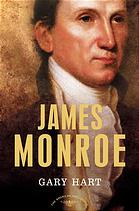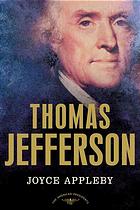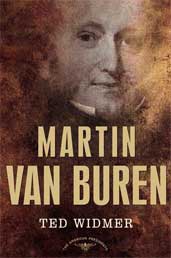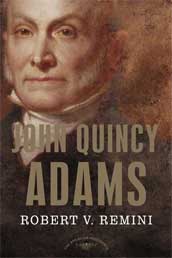President #5, C-SPAN Historians Ranking #14
What’s So Bad About Feeling Good?

James Monroe was the last of a series of three Virginia presidents, following Thomas Jefferson and James Madison. And, since he didn’t write the Declaration of Independence or the Constitution, Monroe is remembered mainly for his eponymous foreign policy doctrine. And, some people think that John Quincy Adams wrote that. But, former Senator Gary Hart does his best to stick up for James Monroe, whom he describes as the first “national security president.”
Hart devotes most of this biography of Monroe to his foreign policy efforts. The Panic of 1819, America’s first recession borne out of business cycles is glossed over. The Missouri Compromise is discussed mainly to show how little Monroe had to do with it. The fact that Monroe faced only token opposition in his run for the Presidency in 1816 and then none at all in 1820 gets a page.
But, it is Monroe’s ability to establish one of the cornerstones of American foreign policy that Hart concentrates on. Monroe, who suffered through some unfortunate experiences as a diplomat in Europe, ended up being one of the most effective Presidents in dealing with Europe and preserving the security of the nation.
James Monroe was born on April 28, 1758 in Westmoreland County, Virginia. When he was a 17-year old student at William and Mary, Monroe and a group of older students, after hearing about the battles of Lexington and Concord, led a raid on an armory. The weapons they took would be used to form a regiment in the Virginia Militia.
When he was just 18, Monroe accompanied George Washington’s troops for their fateful crossing of the Delaware. Monroe would fight in the Battle of Trenton. In 1851, artist Emmanuel Leutze would insert Monroe into his painting Washington Crossing the Delaware. (He is the man holding the flag.)
In 1780, Virginia governor Thomas Jefferson asked Monroe to come back home to help with the militia there. Jefferson also tutored Monroe in law, seeing Monroe as a future political leader.
In 1782, Monroe was elected to the Virginia House of Delegates. One year later, Monroe was elected to the Confederation Congress. However, Monroe was not asked to participate in the Constitutional Convention in 1787.
Monroe originally opposed the Constitution, but made his peace with it. He ran for a seat in the House in the 1st Congress, but he lost to Madison. (This is the only time two future Presidents ever ran against each other for a seat in Congress.)
In 1790, Monroe won a seat in the Senate. It’s hard to judge Monroe’s Senate career since all activities of the Senate during his term (1790-1794) were not made public. Monroe was known to be an advocate of opening the Senate’s business to the public as the House was. However, this would not happen until after Monroe left office.
In 1794, President George Washington found himself in need of a new Minister to France. The Revolutionary Government of France had asked for the old Minister, Gouverneur Morris, to be recalled as they felt he was too pro-British.
Washington turned to Monroe, who was both sympathetic to the French Revolution, but also somewhat levelheaded. Washington was not afraid (at this time) to appoint people to high office even if they were opposed to his policies.
Monroe’s service in France didn’t go well. Washington’s administration remained strongly pro-British. Chief Justice John Jay had been dispatched to London to negotiate a treaty to alleviate tensions between Britain and the U.S. Monroe assured the French that they had nothing to fear from the treaty. Monroe believed that the U.S. would still back the terms of the Alliance signed back in 1777.
But, Jay was not forthcoming to Monroe about what he intended to negotiate. The treaty ended up being pro-British. The French, naturally, hated it. Monroe ended up looking foolish. In 1796, Washington recalled Monroe.
Monroe returned home, but wasn’t out of public life for too long. He was elected Governor of Virginia in 1799 and served for three years. In 1803, President Jefferson asked Monroe to go overseas again.
The first job for Monroe would be to assist Robert Livingston in negotiations with Napoleon for the purchase of New Orleans. Monroe had long made free navigation of the rivers of the West one of his pet projects and was eager to help.
When Monroe joined Livingston in Paris, he soon found out that Napoleon just didn’t want to sell New Orleans. He wanted to sell the whole Louisiana Territory. This turned out to be a deal that Monroe, Livingston, and Jefferson couldn’t refuse. The Louisiana Purchase added over 800,000 square miles of territory to the U.S. for just $15 million. (That’s about $ 200 million in today’s dollars.) Even better, Monroe decided not to buy the extended warranty that Napoleon was offering on the deal. He might have gone for rust proofing, but Livingston told Monroe to walk away.
After concluding this business, Jefferson sent Monroe to London to serve as the U.S. Minister there. (The U.S. didn’t use the title of ambassador until the late 19th Century.) Monroe’s tenure in London often brought him in conflict with Jefferson.
Monroe negotiated a commercial treaty with the British that he thought would relieve the tensions between the two nations. However, Jefferson rejected the treaty because it did not contain any prohibitions against the impressments of sailors, which was the hot button issue of the day.
When Monroe came home, he was elected Governor of Virginia again in 1811, but he resigned that post to serve as Secretary of State for President Madison. Monroe also served as interim Secretary of War. And, then just as Secretary of State. And then both offices again.
During the War of 1812, Monroe visited soldiers on the front lines in Baltimore, and did some scouting of his own. Monroe is likely the only serving Secretary of State to ever actively participate in a military action.
When Madison’s left the White House (or what was left it after the British burning Washington in 1814) in 1817, Monroe took over. Monroe faced very little opposition from the Federalist Party, which was nearing extinction. Monroe won 183 electoral votes to just 34 for Rufus King.
Monroe, although he was a Republican (now Democrat) and learned from Jefferson and Madison, governed in a much different style. In many respects, Monroe was a “New Republican” similar to Bill Clinton being a “New Democrat.”
Jefferson and Madison feared standing armies. Monroe thought a standing army was vital to the security of the nation. Jefferson feared a central bank, and Madison only grudgingly approved a new one. Monroe embraced the idea of a central bank. Monroe did veto a bill that would have allowed the Federal government to collect tolls on the interstate Cumberland Road. (It would be the only veto by Monroe in his eight years in office.)
Monroe’s background as a soldier in the Revolutionary War gave him a much different perspective on the United States than Jefferson and Madison had. Soon after taking office, Monroe toured the country. This was partly to increase his visibility and partly to drum up support for increased military spending.
While on this tour, Andrew Jackson, ostensibly defending Georgia against pirates, ended up occupying parts of Florida. Jackson also executed two British subjects and he and his troops killed thousands of Indians. Jackson managed to upset the Spanish, British, and a good chunk of the American population. However, Jackson’s occupation of Florida eventually led to diplomatic negotiations with Spain and the eventual purchase of Florida in the Adams-Onis Treaty.
Even though the America economy went into a deep recession in 1819, Monroe faced no opposition when he ran for reelection in 1820. The Federalist Party had few good ideas left and the Republicans co-opted those. No opposition party had yet formed. This caused this era to be called “The Era of Good Feelings.”
Monroe received all but one electoral vote in 1820. A New Hampshire elector named William Plumer voted for John Quincy Adams. Plumer felt that Monroe was not as smart as Adams (which was likely true), and he also wanted to preserve Washington’s distinction for being the only President to be unanimously selected. John Adams, an elector from Massachusetts, didn’t even vote for his own son.
During his second term, Monroe encountered more foreign policy challenges. The South American countries were winning their independence from Spain. Congressional leaders such as Henry Clay demanded that Monroe extend diplomatic recognition immediately. (Clay didn’t dislike Monroe; he just thought he was a nonentity.)
However, Monroe had to wait for Spain to complete its ratification of the treaty on Florida. Once this was accomplished, Monroe extended diplomatic recognition to new countries like Argentina and Colombia. But, this led to another issue.
Russia was refusing to accept any diplomatic representatives from the South American countries. This was because Russia, along with Prussia and Austria, had formed something called The Holy Alliance. These three nations had ideas on recolonizing the South American nations and giving them back to Spain. Or perhaps keeping them for themselves.
For Monroe, this was unacceptable. Secretary of State John Quincy Adams entered into discussions with British Foreign Minister George Canning to come up with a solution.
Canning said the British would be willing to go along with an American proposal to declare that the Western Hemisphere was off limits for further colonization. Adams relayed the information to Monroe, who decided to include language outlining this in his Annual Message to Congress in December of 1823.
In his message, Monroe issued this famous statement:
In the discussions to which this interest has given rise and in the arrangements by which they may terminate the occasion has been judged proper for asserting, as a principle in which the rights and interests of the United States are involved, that the American continents, by the free and independent condition which they have assumed and maintain, are henceforth not to be considered as subjects for future colonization by any European powers. . .
Hart spends a whole chapter giving Monroe credit for “The Monroe Doctrine.” Many historians have said it was mostly the work of Adams. British historians tend to give credit to Canning. But, Hart asserts, Monroe was the one who drafted the language. And, it was Monroe’s idea just as much as it was Adams.
In addition to the language about the Western Hemisphere, Monroe included statements indicating that the United States would stay out of any European issues. This part of the Monroe Doctrine would later sound quaint as history showed us.
Adams benefits from leaving voluminous notes behind of his work as Secretary of State (and just about everything else). Monroe was not the most organized of men. Also, he was not as learned as Adams, so it is natural to think that the Harvard grad was the actual author instead of the William and Mary dropout.
Originally, the Monroe Doctrine was called “The Principles of 1823.” But, as time went on, Monroe ended up with the writing credit. The net effect of this was to make the question on your history test in high school to be “When was the Monroe Doctrine written?” rather than “Who wrote the Principles of 1823?”
“The Era of Good Feelings” didn’t last until the next election in 1824, when Monroe’s successor would be chosen. The country was starting to divide itself over the issue of slavery. The Missouri Compromise, signed by Monroe in 1820, admitted Missouri into the Union as a slave state, Maine as a free state, and then prohibited slavery north of 36 degrees, 30 minutes. Monroe had little to do with the passage of the Missouri Compromise, although he feared that it was a sign that the country would eventually be torn apart by the issue of slavery.
Adams prevailed in the turbulent 1824 election. This turned out to be very bad for Monroe’s retirement plans, according to Hart.
During his diplomatic tours in Europe, Monroe had borrowed against much of his landholdings to pay his expenses. Monroe expected to be reimbursed when he returned to the U.S. But, Congress never got around to paying Monroe. Then, Monroe decided not to pursue the matter while he was serving in Madison’s Cabinet or as President.
Once out of office, Monroe realized that he was going to be desperately short of money. He sent reams of papers to Congress asking to be reimbursed and even asked Jefferson and Madison to intervene for him. However, Monroe’s expense account payments got caught in politics. Andrew Jackson’s supporters, upset over Monroe failing to back him in the 1824 election, blocked any action on the matter.
Monroe had to sell his home in Virginia and move in with a daughter in New York City. He had to accept private charity. He died, mostly forgotten just six years after leaving the White House, on July 4, 1831.
James Monroe may only be remembered for one foreign policy statement he made in 1823. But, Monroe, in the view of Hart, was crucial in bringing America along from its adolescence to young adulthood. In many ways, he was the right man for the era. He wasn’t Thomas Jefferson or James Madison. But, Monroe didn’t need to be like those two men. His Presidency may not have been memorable, but it certainly wasn’t a bad time for the country.
Other stuff: Monroe was originally buried in the New York Marble Cemetery, but was later reinterred at Hollywood Cemetery in Richmond, Virginia. John Tyler is also buried there. A grandson of Alexander Hamilton, Laurens Hamilton, died after falling overboard on the ship that was carrying Monroe’s body from New York to Richmond.
The James Monroe Foundation has tried building a museum around Monroe’s birthplace, but it still appears to be in the planning stages. You can visit one of James Monroe’s homes, Ash Lawn-Highland, in Charlottesville, Virginia. It is run by William and Mary University.
I took the SATs at James Monroe High in North Hills, California. The school newspaper is called “The Doctrine.” The sports teams are, naturally, the Vikings.
Monroe’s Vice President, Daniel Tompkins, served two full terms for him. No other Vice President would serve two full terms for the same President until Thomas Marshall did so for Woodrow Wilson from 1913-1921. Tompkins died three months after leaving office, most likely from the effects of alcoholism.
And yes, I’m on vacation. I wrote this before I left and scheduled it to appear later.












 As I careen through the roster of American presidents, I knew that eventually I would hit bottom. There had to be someone whom historians considered to be THE WORST President ever. Historian
As I careen through the roster of American presidents, I knew that eventually I would hit bottom. There had to be someone whom historians considered to be THE WORST President ever. Historian 











 In this biography of the Third President, UCLA professor Joyce Appleby begins the seventh chapter of the book with this sentence: “Americans’ most pressing history assignment is coming to terms with Thomas Jefferson.”
In this biography of the Third President, UCLA professor Joyce Appleby begins the seventh chapter of the book with this sentence: “Americans’ most pressing history assignment is coming to terms with Thomas Jefferson.” Martin Van Buren is not a president who inspires people in this day and age. He exists mainly as a name to remember when you’re trying to remember the names of all the presidents. Fortunately,
Martin Van Buren is not a president who inspires people in this day and age. He exists mainly as a name to remember when you’re trying to remember the names of all the presidents. Fortunately,  John Quincy Adams had one of the most distinguished careers in service to the United States that any person may have had. However, the four years he was president, from 1825 through 1829, were a series of political missteps compounded by the fact that he was the only president ever to be elected despite not getting the most ELECTORAL votes.
John Quincy Adams had one of the most distinguished careers in service to the United States that any person may have had. However, the four years he was president, from 1825 through 1829, were a series of political missteps compounded by the fact that he was the only president ever to be elected despite not getting the most ELECTORAL votes.